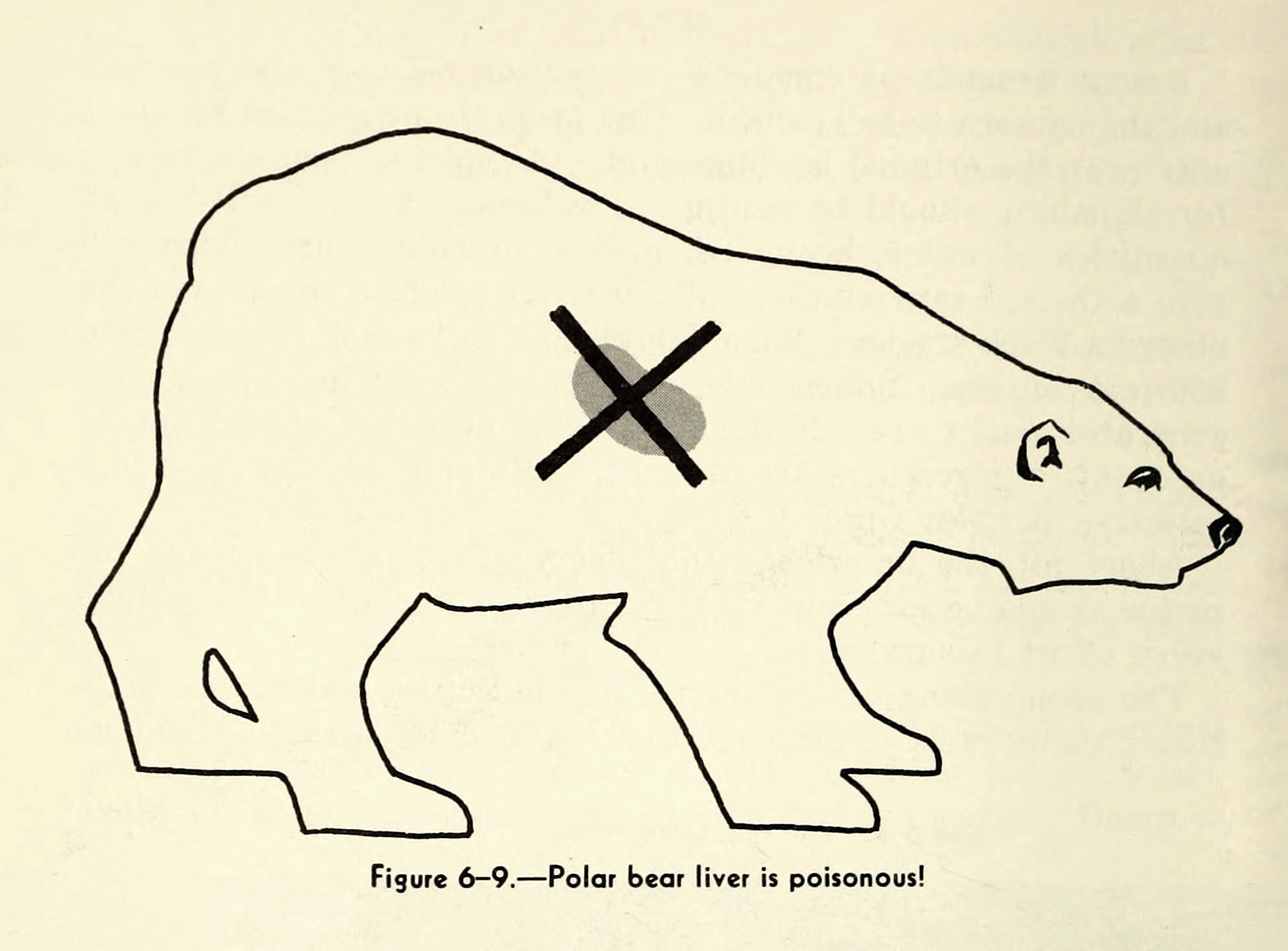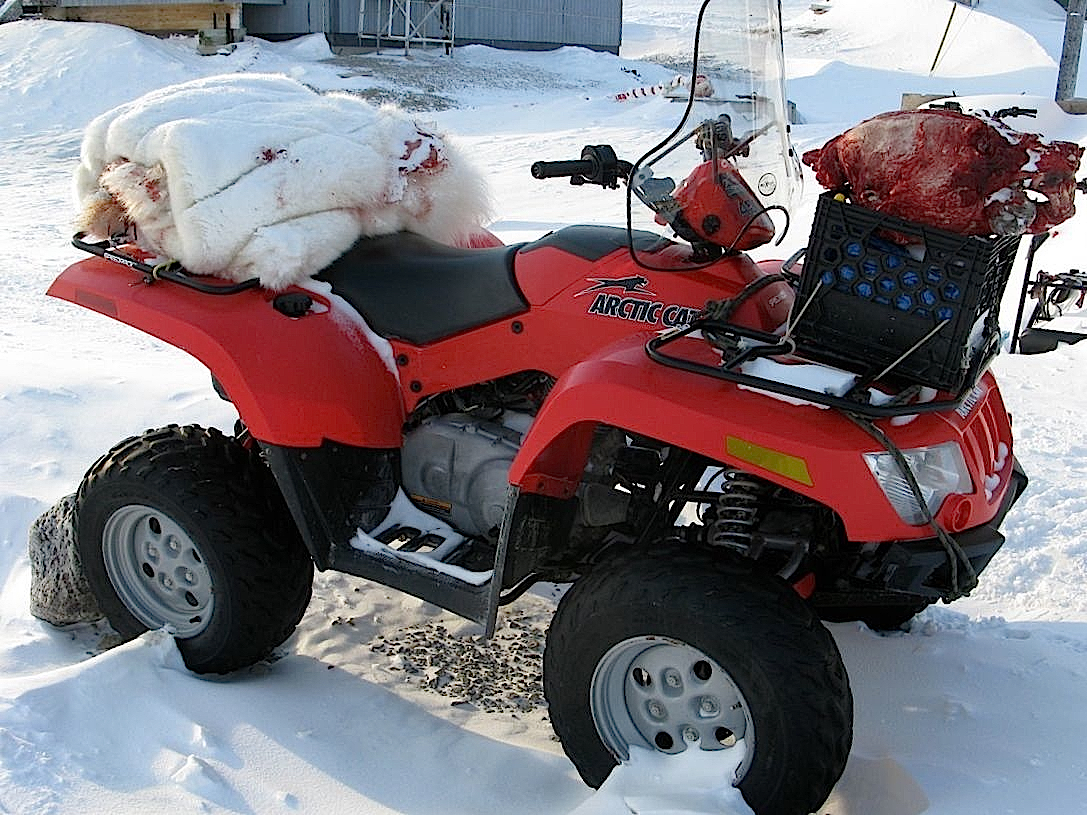Eating the white bear: An Arctic icon’s place on the menu
Throughout 8,000 years of shared history, humans have regarded the polar bear with wonder, terror, and fascination. It has been spirit guide and fanged enemy, trade good and moral metaphor, symbol of ecological crisis—and food source. The bear’s meat itself is rich with associations that speak of the fraught relationships between our two species.
Paraphrasing the French analyst of totemism Claude Lévi-Strauss, one could claim that the North’s Native peoples are taken with polar bears not only because they are spiritually potent—“good to think”—but also because they are physically potent—“good to eat.”
Throughout Arctic history the bear has served as food, though in most indigenous societies, whales, walrus, seals, caribou, or reindeer provided the bulk of the diet. Unfamiliar dishes or ingredients like bear meat strike Western palates as surreal or exotic and in the case of endangered species, might also be seen as “politically incorrect”—but from our births onward, the culture that surrounds us shapes our food preferences and what we consider “normal” or acceptable.
[The first Arctic-wide look at polar bears’ sea ice habitat finds conditions worsening everywhere]
Food can be a marker of belonging, contributing to a group’s self-image and coherence. Food taken directly from one’s surroundings is symbolic of place, forming a link with a people’s history. This is why even in countries that banned polar bear hunting, such as the United States, Native groups with a tradition of hunting polar bears are permitted to keep hunting them (and other animals covered by the Marine Mammal Protection Act).

Together with the bear’s humanlike appearance, the richness of bear meat and its rarity in modern diets seem to account for non-Native people’s rejection of it. But our culinary preferences have changed. In nineteenth-century North America, bear meat (though not that of polar bears) was standard fare. Settlers also used bear fat to fry other foods and preferred it to butter—an English visitor complained that everything he ate tasted of bear.
Unlike medieval royalty who kept polar bears in menageries—or later, zoos—which pampered rare collectibles, explorers and whalers, always near starvation, treated the White Bears as survival rations.
For months, “Bear-beef” was often the only course on these men’s menu. The meat is much greasier, however, than beef. Fridtjof Nansen’s captain, Otto Sverdrup, called it a “royal dish” and the explorer himself judged breast of polar bear cub to be delicious. Of course, hunger always has been the best sauce and could have swayed culinary opinions. “Heaven had sent us succor at a time of utter distress,” one castaway recalled, of a polar bear windfall, “and our gratitude for this miraculous gift was apparent in our overflowing happiness.”
Having run out of provisions on one of the numerous searches the British launched for Sir John Franklin, Dr. Elisha Kent Kane ate raw, frozen meat from a polar bear head that he had saved as a specimen and called it a godsend. He described the meat of lean bears as “the most palatable food” and “rather sweet and tender,” but warned against well-fed bears, which were made nearly inedible by “the impregnation of fatty oil throughout the cellular tissue.”

Would-be connoisseurs should keep in mind the possibility of negative side effects from the consumption of polar bear meat.
“I did not care to try how it tasted,” wrote William Scoresby, “for I was afraid that my hair would turn grey before its time, for the seamen are of opinion, that if they eat of it, it makes their hair grey.”
More serious is hypervitaminosis A, an excess of the vitamin that can be contracted from eating the liver of polar bears, seals, walrus, or huskies. Affecting the central nervous system, it can cause hair loss, extreme peeling of the skin, birth defects, liver problems, vomiting, blurred vision, loss of muscle coordination, and even death. One officer swore never again to eat bear liver, no matter how much it might tempt him, after his crew showed symptoms akin to carbon monoxide poisoning. Native peoples have long been aware of this danger, as have explorers, though some felt no worse after eating of the liver.
Research has shown that a healthy adult person can tolerate ten thousand units of vitamin A. Trouble, if it comes, comes between twenty-five thousand and thirty-three thousand units. One pound of polar bear liver—a fist-sized chunk and barely a meal—can contain nine million units of vitamin A. The occasional lack of liver toxicity that some explorers reported can be explained by differences in the age, hibernation, and feeding habits of the bear.

Equally bad is trichinosis, a parasitic disease contracted by eating the raw or undercooked flesh of pigs or wild game, including bear. Its symptoms can include fever, muscle pain, and fatigue, as well as inflammation of the heart muscle, lungs, or brain, which have led to a few deaths.
In 1897, the Swedish aeronaut and physicist Salomon August Andrée and his two companions perished after their balloon was forced down on the ice before they ever got close to the North Pole. They survived the crash, but the trichinella parasite from a polar bear on which the trio later fed has been suspected in their deaths. Even dried bear meat can cause the disease, and three members of a Gambell, St. Lawrence Island family became sick after eating jerked polar bear intended for their dogs—so cook those steaks well.
Native peoples avoided polar bear liver because of its vitamin A concentration, and, like explorers and whalers, fed it only to their dogs. Modern Inuit and Inupiat value the flavor nuances of different bears or parts of a bear. Some prefer den polar bears instead of bears caught in the open, because they taste better. Like their neighbors, the Cree, some consider the front and back paws (tukiq) the best eating.
For many Inupiat, polar bear meat remains a favorite meal and a prestigious gift. Nowadays, when a polar bear has been killed, a call goes out on a village radio channel, asking people to get some. The hunter normally keeps the skin, a trophy and commodity. The rest of a bear still is widely shared, a token of group identity and solidarity, a kind of Arctic communion. Unlike the whalers and explorers, who saw it as staple or last resort, indigenous peoples have always considered eating polar bear a reaffirmation of community and of their beliefs, as much as an act of physical nourishment.

Like the widespread idea that animal parts such as the blood, heart, or testicles give power to those who ingest them, the human craving for novelty and the desire to understand the unknown by tasting it have shaped human culinary exploration from the beginning. It is not surprising that, in a world of potentially lethal pufferfish entrées and coffee ennobled in civet intestines, polar bear meat has found a place in fine dining.
The Norwegian restaurateur André Grytbakk, manager of the upscale Huset in Longyearbyen, Svalbard, occasionally dishes out polar bear steaks with potatoes or a slice of roast in red wine sauce. He also offers a bear meat snack with lingonberry pickle. As it’s “a rough kind of meat,” the chef recommends a heavy wine with it, such as full-bodied Bordeaux, from the Huset’s 1,200-bottle cave.
The Radisson in Longyearbyen, which bills itself as the northernmost hotel in the world, even issues certificates to diners who have “eaten a [sic] polar bear entirely at their own risk.” These certificates also serve as liability releases for the hotel. According to one guest, the bear meat there is boiled for six hours and fried for another two, to kill parasites.
The Hvide Falk (“White Falcon”) in Ilulissat, Greenland, also serves Arctic mammals protected by international conventions. Past spreads have included whale stew, narwhal sushi, thin slices of beluga, and cured polar bear meat. Some tourists feel tempted yet conflicted—for them, curiosity battles convictions, and sin trumps conservationist scruples.
“We must still protect the whales,” one German woman insisted to a journalist before sampling what to her were forbidden meats.
Luckily, polar bear is not often found on these menus. Though hunting the threatened species is illegal on Svalbard, occasionally one is shot in defense of human life.
[As Norway’s Arctic draws visitors, more polar bears get shot]
Arctic gourmet cooking remains an exception, but holidays matter up north. In the far American Northwest, on Little Diomede Island, a stormy Bering Strait outcrop near the International Date Line, turkeys are hard to find. Undaunted by this, the islanders celebrate Thanksgiving by serving common local fare in the village school. Like many in Alaska, these Inupiat still largely depend on the sea’s bounty—blue crab and bowhead whale, seal, walrus, and polar bear, which they can legally hunt. Butchered properly, a polar bear yields up to five hundred pounds of meat, enough food for dozens of guests. Little Diomede resident and tribal coordinator Frances Ozenna has two favorite recipes:
Diced: Dice polar bear meat, leaving fat on some chunks of meat. Season pieces with bouillon, onion, Mrs. Dash Seasoning Blend, and salt. Boil. (Chef’s note: Polar bear fat is drier than walrus or seal blubber. It is neither fatty nor runny and is subtle in taste and very tender.) Diced, variation: Cook polar bear meat with frozen, sliced fermented walrus flipper. (Chef’s note: When you eat the two together it sweetens the bear meat, and the bear takes away the greasy taste of the fermented flipper.) Serve with mixed greens and [seal] oil.
Stew: For choice cuts, choose meat from the back of the polar bear shoulder blade. Dice meat. Marinate in refrigerator for one to two days with beef bouillon, Lea & Perrins Worcestershire Sauce, garlic, onion, and Mrs. Dash Seasoning Blend. After marinating, rinse well to remove some of the blood. (Chef’s note: A small amount of brown sugar can also be added to the seasoning.)
Boil a pot of water and add onion, Mrs. Dash, bouillon, salt, and Worcestershire sauce. Add meat and simmer for 1.5 to 2 hours. Add rice, potatoes, and carrots, if available. Thicken with flour, cornstarch, or elbow macaroni about ten minutes before the soup is done. Let stew rest before serving.
Serve with homemade corn bread or biscuits. Lacking polar bear meat, you can substitute brown bear or black bear. (Or pork.)
It is hard to anticipate how food preferences will change. In some future day, as a Montreal Gazette column from the 1950s surmised, southern Canadian cooks might be appraising polar bear cuts for steaks or bearburgers.
In that case, or if you ever find yourself at Grytbakk’s Huset, don’t hesitate. Bon appetit! Nigiñaqsiruq! Dig in!
Michael Engelhard is the author of American Wild: Explorations from the Grand Canyon to the Arctic Ocean and of Ice Bear: The Cultural History of an Arctic Icon, from which this article has been excerpted. Trained as an anthropologist, he lives in Fairbanks, Alaska and works as a wilderness guide in the Arctic.





